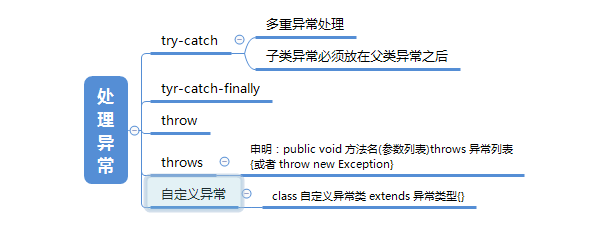201521123118《java程序与设计》第9周学习总结
1. 本周学习总结
1.1 以你喜欢的方式(思维导图或其他)归纳总结异常相关内容。


2. 书面作业
1. 常用异常
题目5-1
1.1 截图你的提交结果(出现学号)

1.2 自己以前编写的代码中经常出现什么异常、需要捕获吗(为什么)?应如何避免?
答:数组越界异常,类型转换异常等,这些不需要捕获。uncheckd Exception 在写代码的时候规范一点,checkd Exception 使用 try catch fnally 进行异常的chuli;
1.3 什么样的异常要求用户一定要使用捕获处理?
除了Error与RuntimeException及其子类以外的异常都是Checked Exception,Checked Exception一定要使用捕获处理。
2. 处理异常使你的程序更加健壮
题目5-2
2.1 截图你的提交结果(出现学号)

2.2 实验总结
答:这一题比较好做一点,如果发生异常,则下一条语句不执行,直接执行catch语句,所以这题的i++在遇到非数字字符是 不执行。
3. throw与throws
题目5-3
3.1 截图你的提交结果(出现学号)

3.2 阅读Integer.parsetInt源代码,结合3.1说说抛出异常时需要传递给调用者一些什么信息?
public static int parseInt(String s) throws NumberFormatException {
return parseInt(s,10);
}
public static int parseInt(String s, int radix)
throws NumberFormatException
{
/*
* WARNING: This method may be invoked early during VM initialization
* before IntegerCache is initialized. Care must be taken to not use
* the valueOf method.
*/
if (s == null) {
throw new NumberFormatException("null");
}
if (radix < Character.MIN_RADIX) {
throw new NumberFormatException("radix " + radix +
" less than Character.MIN_RADIX");
}
if (radix > Character.MAX_RADIX) {
throw new NumberFormatException("radix " + radix +
" greater than Character.MAX_RADIX");
}
int result = 0;
boolean negative = false;
int i = 0, len = s.length();
int limit = -Integer.MAX_VALUE;
int multmin;
int digit;
if (len > 0) {
char firstChar = s.charAt(0);
if (firstChar < '0') { // Possible leading "+" or "-"
if (firstChar == '-') {
negative = true;
limit = Integer.MIN_VALUE;
} else if (firstChar != '+')
throw NumberFormatException.forInputString(s);
if (len == 1) // Cannot have lone "+" or "-"
throw NumberFormatException.forInputString(s);
i++;
}
multmin = limit / radix;
while (i < len) {
// Accumulating negatively avoids surprises near MAX_VALUE
digit = Character.digit(s.charAt(i++),radix);
if (digit < 0) {
throw NumberFormatException.forInputString(s);
}
if (result < multmin) {
throw NumberFormatException.forInputString(s);
}
result *= radix;
if (result < limit + digit) {
throw NumberFormatException.forInputString(s);
}
result -= digit;
}
} else {
throw NumberFormatException.forInputString(s);
}
return negative ? result : -result;
}
答:根据输入的值,对异常if做选择,输出异常的原因。
4. 函数题
题目4-1(多种异常的捕获)
3.1 截图你的提交结果(出现学号)

3.2 一个try块中如果可能抛出多种异常,捕获时需要注意些什么?
答:需要注意子类异常必须要在父类异常之前,虽然系统会报错。
5. 为如下代码加上异常处理
byte[] content = null;
FileInputStream fis = new FileInputStream("testfis.txt");
int bytesAvailabe = fis.available();//获得该文件可用的字节数
if(bytesAvailabe>0){
content = new byte[bytesAvailabe];//创建可容纳文件大小的数组
fis.read(content);//将文件内容读入数组
}
System.out.println(Arrays.toString(content));//打印数组内容
5.1 改正代码,让其可正常运行。注1:里面有多个方法均可能抛出异常。注2:要使用finally关闭资源。
public static void main(String[] args){
byte[] content = null;
FileInputStream fis = null ;
try {
fis = new FileInputStream("testfis.txt");
int bytesAvailabe = fis.available();
if(bytesAvailabe>0){
content = new byte[bytesAvailabe];//创建可容纳文件大小的数组
fis.read(content);
}
System.out.println(Arrays.toString(content));//打印数组内容
}catch (IOException e) {
// TODO Auto-generated catch block
e.printStackTrace();
}//获得该文件可用的字节数
finally{
if (fis!= null) {
try {
fis.close();
} catch (IOException e) {
// TODO Auto-generated catch block
e.printStackTrace();
}
}
}
}
5.2 使用Java7中的try-with-resources来改写上述代码实现自动关闭资源.
public static void main(String[] args) throws IOException {
byte[] content = null;
try (FileInputStream fis = new FileInputStream("testfis.txt")😉{
int bytesAvailabe = fis.available();//获得该文件可用的字节数
if(bytesAvailabe>0){
content = new byte[bytesAvailabe];//创建可容纳文件大小的数组
fis.read(content);//将文件内容读入数组
}
System.out.println(Arrays.toString(content));//打印数组内容
} catch (IOException e) {
e.printStackTrace();
}
}
不理解。
$重点考核:使用异常改进你的购物车系统(未提交,得分不超过6分)
举至少两个例子说明你是如何使用异常处理机制让你的程序变得更健壮。
说明要包含2个部分:1. 问题说明(哪里会碰到异常)。2.解决方案(关键代码)
3. 码云上代码提交记录





